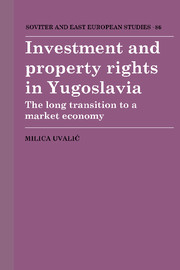Book contents
- Frontmatter
- Contents
- List of figures
- List of tables
- Preface and acknowledgements
- Introduction
- Part I The institutional and theoretical framework
- Part II Empirical evidence on the nature of the Yugoslav system
- Part III Pressure for more radical reforms in Yugoslavia
- 8 Early attempts at introducing investment incentives
- 9 Current property reforms
- 10 Specific features of the Yugoslav transition
- 11 An overview of conclusions
- Notes
- List of references
- Index
- Series list
11 - An overview of conclusions
Published online by Cambridge University Press: 11 January 2010
- Frontmatter
- Contents
- List of figures
- List of tables
- Preface and acknowledgements
- Introduction
- Part I The institutional and theoretical framework
- Part II Empirical evidence on the nature of the Yugoslav system
- Part III Pressure for more radical reforms in Yugoslavia
- 8 Early attempts at introducing investment incentives
- 9 Current property reforms
- 10 Specific features of the Yugoslav transition
- 11 An overview of conclusions
- Notes
- List of references
- Index
- Series list
Summary
Since the early 1950s Yugoslavia has been trying to develop its own model of socialism, based on workers' self-management, extensive decentralization, social property, and an increasing use of the market mechanism. This model of self-managed market socialism has been pursued through continuous economic reforms, effectively entailing a departure from the traditional centrally planned economy in many important respects. This book has tried to illustrate how, despite all the reforms, some of the aspects of the Yugoslav economy have remained essentially unchanged with respect to the pre-self-management period, and very similar to those in other former socialist economies. The specific field of investment was chosen for illustration, for it is probably the most important area where reforms have not led to substantial changes in enterprise behaviour.
Since Yugoslavia has usually been regarded as being both a socialist and a self-managed market economy, two theoretical frameworks were considered in order to explain investment behaviour of the Yugoslavtype enterprise: one which places emphasis on self-management, and another which focuses on the distinctive features of the socialist economic system.
According to the dominant theory of the investment behaviour of the LMF – developed by Vanek, Furubotn, and Pejovich – the LMF will be less willing to invest in capital assets from retained earnings than its capitalist counterpart, for reasons connected with collective ownership of capital. Limited property rights are expected to result in a specific problem of the LMF, since workers cannot sell their jobs and future income streams, but can benefit from undertaken investment only for the duration of their employment within the given firm.
- Type
- Chapter
- Information
- Investment and Property Rights in YugoslaviaThe Long Transition to a Market Economy, pp. 210 - 215Publisher: Cambridge University PressPrint publication year: 1992



